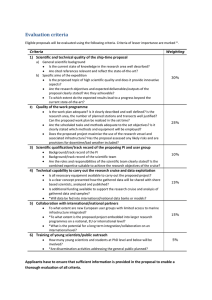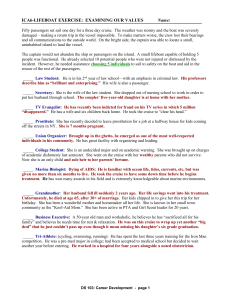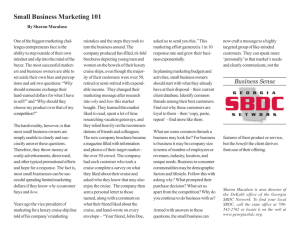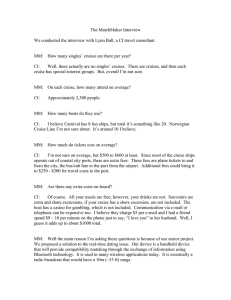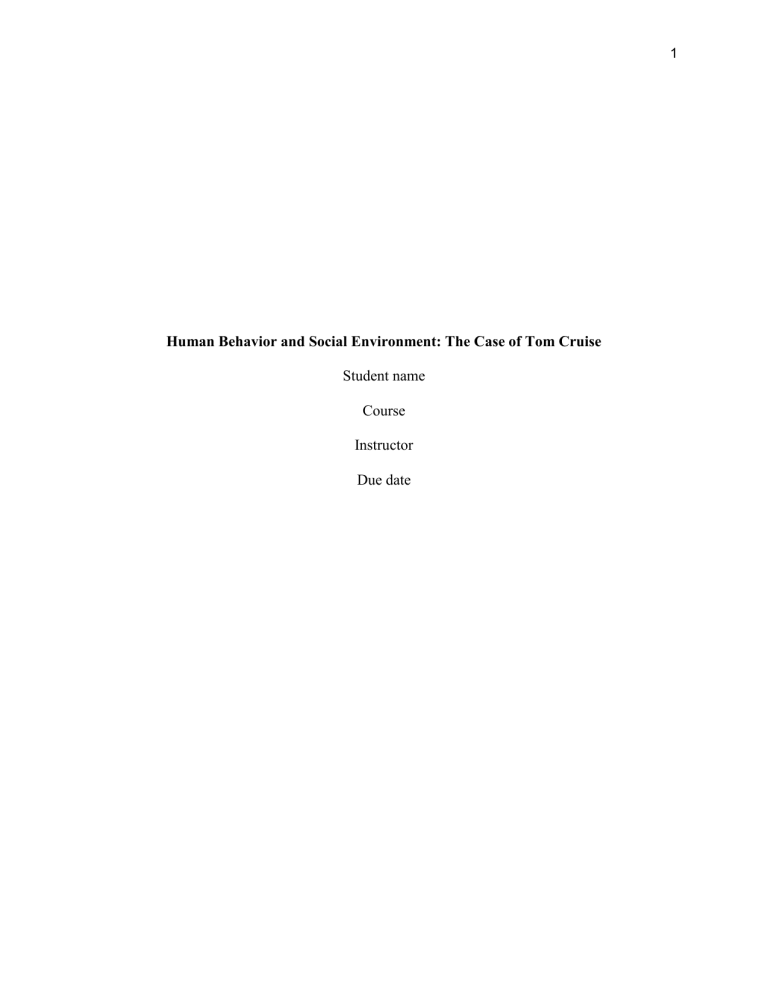
1 Human Behavior and Social Environment: The Case of Tom Cruise Student name Course Instructor Due date 2 Human Behavior and Social Environment: The Case of Tom Cruise Introduction Tom Cruise is an internationally recognized name in the entertainment industry who is praised for his excellent acting skills and approachable on-screen demeanor (Svetkey, n.d.). To better understand how human behavior theories may be applied to evaluate a person of such popularity this paper uses his biography as an exciting subject for a thorough case study. In particular, the study makes use of theories of human behavior to look into individual and environmental factors throughout a particular developmental stage. This study aims to better understand Tom Cruise's life experience by drawing on two key works by Elizabeth D. Hutchison, "Dimensions of Human Behavior—Person and Environment" and "Dimensions of Human Behavior—The Changing Life Course," alongside other sources. This in-depth analysis also examines the biopsychosocial and spiritual aspects of Cruise's life, analyzes his roles within various environmental systems in accordance with the ecological systems theory of Bronfenbrenner, and assesses his developmental stage using the psychosocial development theory and cognitive development theory of Erikson and Piaget.. A public figure's complex human behavior will be better-understood thanks to this in-depth investigation. Biopsychosocial-Spiritual Assessment Tom Cruise's life can be evaluated through the biopsychosocial-spiritual framework, which encompasses various facets of his existence and is the central premise of existence for any individual (Hutchison, 2018). Biologically, Cruise maintains excellent physical health, actively participating in extreme stunts for his movies (Mellardo, 2023). According to a statement by Men’s Health (2023), Tom Cruise has maintained a youthful body in his 61-year-old body. Given the roles he plays, it is imperative that he would require to be physically fit to be effective 3 in his main action movies (Mellardo, 2023). Despite the physically demanding nature of his profession, Cruise exhibits remarkable resilience and determination to push the boundaries of his physical capabilities, often performing his stunts. This biopsychosocial dimension aligns with the concept of resilience discussed in the academic texts, highlighting his ability to adapt and thrive under challenging circumstances. Cruise has dealt with his fair share of psychological issues in the spotlight. Erikson's psychosocial development theory can be used to analyze Cruise’s high-profile career and personal life, both of which have come under scrutiny. At 59 years old, Cruise probably moves between Erikson's stages of generativity and stagnation. Generativity is the desire to impact the world and leave a lasting legacy, demonstrated by Tom Cruise's successful career and his contributions to the film industry. His commitment to craft, dual roles as an actor and producer, and tenacity are in line with Erikson's expectations for this stage of life. Cruise constantly aspires to create and innovate—two qualities that are hallmarks of generativity. A sense of accomplishment and fulfillment is also brought about by successfully resolving this stage, which is something that Cruise appears to exemplify through his work, according to Hutchison (2018). With an extensive network of friends and colleagues, Cruise is a well-known figure in Hollywood on the social scene (Scott, 2019). His deep social ties may serve as a protective factor, mitigating the strains and difficulties of his line of work. This social support system, which has its roots in the tight-knit Hollywood community, reflects the importance of social networks in one's well-being. Cruise's spiritual dimension is intriguing, as he has a welldocumented affiliation with Scientology, a belief system that has sparked both intrigue and controversy. His dedication to Scientology exemplifies the profound impact that spirituality can have on a person's morals and way of life. The investigation of his spiritual side is evidence of 4 how—as stressed in academic literature, a person's spiritual beliefs are connected to their behavior and decisions. Developmental Stage Analysis The psychosocial development theory of Erikson can be used to understand Tom Cruise's developmental stage better. He is navigating the crucial middle adulthood stage of generativity versus stagnation at the age of 61 (Hutchison, 2019). The emphasis at this stage is on making a difference in the world and leaving a lasting impression, and Cruise's career is a striking example of this developmental challenge. His prolific filmography, innovative roles, and production ventures exemplify his commitment to generativity. Erikson's theory that emphasizes that achieving generativity is essential for personal fulfillment during midlife is supported by Cruise's work because it benefits the individual and advances society as a whole (Hutchison, 2019; Hutchison, 2018). Piaget's theory on cognitive development sheds more light on Cruise's cognitive skills (Hutchison, 2019). Tom Cruise has been able to secure deals, and his exemplary acting roles are a testimony to his prowess in cognitive abilities and high level of self-awareness. He can make wise decisions about his career, family, and involvement in the community because his cognitive development is at its peak at this age (NZ Herald, 2021). This is because it is challenging to reach the level he is if he has issues with cognitive abilities. Cruise's adaptability and problemsolving abilities are essential in the complex and demanding world of filmmaking, where he has repeatedly shown his versatility and ability to excel in various roles. It is not mentioned that Cruise had a rough childhood, but his toughness in his adult life explains sound childhood. 5 Environmental Factors and Roles in Groups Bronfenbrenner's ecological systems theory aids in understanding how an individual’s behavior is influenced by his environment and community interactions (Tudge & Rosa, 2020). The theory would explain Tom Cruise's roles within various family and community environmental contexts. Cruise's family, including his children, ex-wives, and significant others, significantly impacts his life choices and decisions at the microsystem level (NZ Herald, 2021). The dynamics of his family relationships have come under public scrutiny, which has added another level of complexity to his already complex life. Hutchison’s (2018) book on “Dimensions of Human Behavior: The Changing Life Course” emphasizes how the microsystem, particularly family relationships, dramatically influences an individual's behavior and choices. Family relationships that Cruise has experienced mirror the complex interaction of environmental and personal factors. Individuals are a product of their internal and external environment (Hutchison, 2019). In this regard, the foundation of Cruise's social interactions in his social environment is his involvement in the Hollywood film industry and his numerous partnerships with directors, costars, and production teams. This sphere encompasses his professional life and a large portion of his social network, although Cruise has successfully kept his personal life private (Scott, 2019). His contributions to the industry have earned him a respected position within this sphere, which is crucial for his overall well-being as it provides a sense of purpose and accomplishment. This mesosystem involvement demonstrates the impact of social networks on an individual's development and behavior. Tom Cruise's interactions with the media, which were a key factor in forming his public perception, are included in his involvement with the external environment system. Within this 6 context, examining how the media has influenced his life is possible. Particularly in the context of well-known individuals like Cruise, scholars, and professionals like Hutchison (2019) emphasize the significance of having an active external system of influence on a person's behavior and well-being. The way the media has portrayed Cruise’s life and deeds is evidence of the influence outside forces have over human behavior and public opinion. The mainstream media and information industry giants like publishers play a key role in how the population perceives a particular individual by acting as gatekeepers (Wettstein et al., 2018). For example, one publisher who released an unauthorized biography of Tom Cruise brought unrest after publishing unverified and possibly vilifying information, especially on personal and sensitive matters such as Cruise’s sexuality and spirituality (Strauss, 2017). Hutchison (2018) notes that the socio-emotional development of a person is key in shaping their personality and even their belief system, which occurs at a very young age. Cruise's affiliation with Scientology significantly impacts his cultural and societal context at the macrosystem level. His belief system is notable because it has generated both support and criticism. For example, he has been on the front page of the Scientology religion, who even came forward to defend him on the basis of character defamation when an unauthorized biography about him was published citing misrepresentation of the data (Strauss, 2017). Tom Cruise's close ties to Scientology are evidence that, according to Hutchison (2019), a person's cultural and social environment significantly impact their values and decisions. His spiritual and cultural upbringing influenced his identity and way of living. However, the celebrity has been observed to have been distancing himself from the religion, signaling a significant stage in Tom’s life (NZ Herald, 2021). 7 Conclusion The case study of Tom Cruise offers a thorough examination of how theories of human behavior can be used to understand the life trajectory of a well-known person better. The complexity of Tom Cruise's life is demonstrated by his dedication to generativity, cognitive prowess, and his multifaceted roles within various environmental systems. This careful examination emphasizes the relevance of applying theoretical understanding to real-world situations, a skill that is essential for both students and professionals in the field of human behavior studies. The biography of Tom Cruise provides a unique insight into how environmental and individual factors combine to influence human growth and behavior. This case study also offers a thorough examination of Tom Cruise's life and emphasizes how theories of human behavior can throw light on the specifics of how events shape a person's behavior and decisions. The importance of comprehending Tom Cruise's life is emphasized by doing this. It offers a distinct perspective on how people develop and behave by serving as an illustration of the interaction between environmental and personal elements. The dynamics of human behavior in academic and everyday environments show how important these theories are for understanding how humans function. 8 References Barson, M., & Wallenfeldt, J. (2023). Tom Cruise | Biography, Movies, & Facts. Encyclopedia Britannica. https://www.britannica.com/biography/Tom-Cruise Hutchison, E. D. (2018). Dimensions of human behavior: the changing life course (6th ed.). Sage Publications, Inc. Hutchison, E. D. (2019). Dimensions of human behavior: Person and environment (6th ed.). Sage. Mellardo, A. (2023, July 12). The Fitness Habits Tom Cruise Lives by To Stay Young & Fit at 61. Eat This Not That. https://www.eatthis.com/tom-cruise-fitness-habits/ Men's Health. (2023, July 6). How Tom Cruise Remains Youthful at 61, and How You Can Too. Men’s Health. https://www.menshealth.com/uk/fitness/a754595/tom-cruises-secrets-ofyouth/ NZ Herald. (2021). Is Tom Cruise done with Scientology? https://www.nzherald.co.nz/entertainment/tom-cruise-appears-to-be-distancing-himselffrom-the-church-of-scientology/ZYXMMHNXYNZASWZQO43GCMI4LE/ Scott, H. (2019, May 19). Tom Cruise Is Intensely Private, But Here’s What We Know About His Personal Life. CINEMABLEND. https://www.cinemablend.com/pop/2471903/tomcruise-is-intensely-private-but-heres-what-we-know-about-his-personallife#:~:text=Tom%20Cruise%20has%20been%20married Strauss, J. R. (2017). Making a Case for Religious Freedom: The Church of Scientology Responds to Claims Made in an Unauthorized Biography of Tom Cruise. Journal of Media and Religion, 16(2), 39–50. https://doi.org/10.1080/15348423.2017.1311121 9 Svetkey, B. (n.d.). Tom Cruise’s success. EW.com. Retrieved October 16, 2023, from https://ew.com/article/1996/12/20/tom-cruises-success/ Tudge, J., & Rosa, E. M. (2020). Bronfenbrenner’s Ecological Theory. The Encyclopedia of Child and Adolescent Development, 1–11. https://doi.org/10.1002/9781119171492.wecad251 Wettstein, M., Esser, F., Schulz, A., Wirz, D. S., & Wirth, W. (2018). News Media as Gatekeepers, Critics, and Initiators of Populist Communication: How Journalists in Ten Countries Deal with the Populist Challenge. The International Journal of Press/Politics, 23(4), 476–495. https://doi.org/10.1177/1940161218785979
